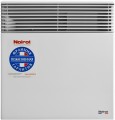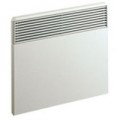Max. power
The maximum power of the heater. The meaning of this parameter depends on the device type and power supply (see above). So, for most types of heaters, we are talking about the highest power output. However, for fan heaters, this parameter also includes the power of the fan motor, and the heating capabilities are somewhat more modest than the claimed maximum power (although not by much). For electric models, the maximum power also corresponds to the maximum power consumption, which determines the connection requirements: for example, for devices of 3.5 kW and more, ordinary sockets are no longer suitable, and some require not 230 V but 400 V.
However, the key point determined by the power of the heater, is the intensity of heating and the ability to effectively heat a particular room. To select the appropriate model, there are special formulas. So, if we are talking about a city apartment or a small office space with a ceiling height of about 2.5 m, then we can assume that a heating power of at least 100 W is required per 1 m² of area. For other situations, more complex methods are used, taking into account the volume of the room, the degree of thermal insulation, climate and solar heating, etc.; they can be found in special sources. Also note that for IR heaters (see "Type"), their own calculation methods are used — this is due to the specific format of work.
Heating area
A very conditional parameter that slightly characterizes the purpose based on the size of the room. And depending on the height of the ceilings, layout and equipment, actual values may vary significantly. However, this item represents the maximum recommended area of the room that the device can effectively heat. This parameter directly depends on the maximum power (see above). It is worth noting that the actual efficiency of the heater in most cases depends not on the area, but on the volume of the room. In light of this, the heating area can only be specified for a certain ceiling height. In most cases, manufacturers mean 2.5 m - this is the standard ceiling height in city apartments. If the ceilings are much higher, the heating area must be recalculated using special formulas. In general, it is worth considering that 1 kW is comfortable for 10 m², however, manufacturers may slightly overestimate the heating area data.
Features
— Thermostat. A device for maintaining a constant room temperature. In the presence of a thermostat, the heater can automatically turn off when the set temperature is reached and turn on when it drops by 1-2 °C.
— Temperature control. The ability to adjust the temperature of the air leaving the heater (in fan heaters and convectors), or the temperature of the heater body (in oil heaters).
— Emergency heating. This function does not protect the heater itself, but the room in which it is installed. When the frost protection is on, the heater automatically maintains the room temperature at 5 °C, turning on and off at the right time. This allows you to protect the walls of the room (for example, a country house) from freezing without the extra cost of electricity or gas.
— Sleep timer. A device for automatically turning off the heater after a predetermined time. The presence of a timer eliminates the need for the user to monitor the time and turn off the heater manually: knowing the approximate time required for heating, is enough to set the timer and the device will turn itself off at the right time.
— Weekly timer. The weekly timer allows you to organize the operation of the heater. Thanks to the weekly timer, you can set up automatic switching on and off of the heater, as well as temperature control depending on the time or day of the week. With the help of the weekly timer, you can set the heating in such a way that when the hea...ter goes to work, it will provide minimal heat, so long as the water in the pipes does not freeze, and shortly before the user arrives, it will begin to provide full heating. The programmer allows you to automate the heating process, while making it economical, rational and efficient.
— Turbo fan. The presence of an additional fan in the design of an oil heater or convector (see "Type"). Such a fan provides forced air circulation, which accelerates the heating of the room and increases the efficiency of the device. Note that fan heaters have this function by definition, so its presence is not indicated for them.
— Fan mode. The ability to operate a fan heater or other device with a fan (see above) in normal ventilation mode, when the heater is turned off and air passes through the device without heating. This mode can be useful, for example, in warm weather, when it is not necessary to warm the air. Of course, the efficiency of such devices is noticeably lower than that of full-sized specialized fans, but in many cases, it is quite enough.
— Oscillation. The system of automatic rotation of the heater body during operation. This allows you to increase the heating zone and provide more uniform heating of the room. Most often, fan heaters and infrared heaters are equipped with this function.
— Chimney effect. It is used in oil radiators to improve air circulation and faster heating of the room. Special slots are made on the body of the device, creating a draft and enhancing natural convection.
— Humidifier. An increase in indoor temperature leads to a decrease in relative humidity. This adversely affects the well-being of people. To prevent this, some models of heaters are equipped with air humidification devices, consisting of a water tank and an evaporator.
— Ionization. Ions are electrically charged molecules. It is believed that the presence of negatively charged ions in the air has a beneficial effect on the health and general well-being of a person. Ionizers are used to saturate the air with such ions.
— Remote control. The presence of a remote control supplied with the heater. The convenience of this function is obvious: the remote control allows you to control the heater from a distance. This is especially useful, for example, on a cold morning, when getting out from under the covers into a cold room would be extremely uncomfortable. Also note that in models with advanced functions (such as a timer), these functions often can only be controlled from the remote control.
— Control via smartphone. The ability to use the user's smartphone as a remote control. By installing the manufacturer's proprietary application, you can change the operating mode, and adjust the temperature and other device parameters directly from your phone.
— Wi-Fi module connection. The ability to expand the capabilities of the heater when connecting a Wi-Fi module (not included). With its help, control from a smartphone becomes available.
— Display. The presence of a display in the design of the heater. Usually, this is the simplest black-and-white screen with a few characters, but even this is enough in this case — almost all key information about the operation of the device can be displayed on this screen: temperature, timer settings, notifications about problems, etc. Thanks to this, control becomes more convenient and visual.

